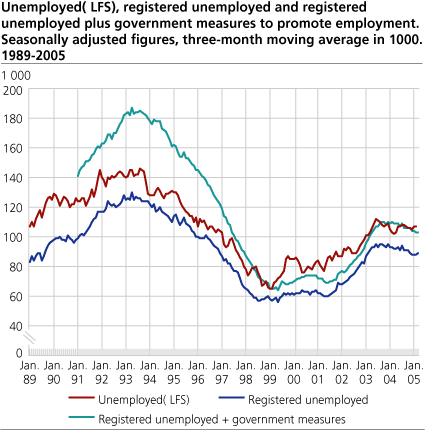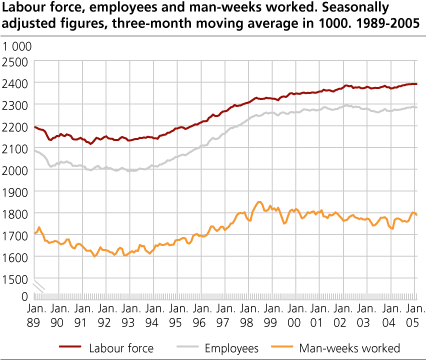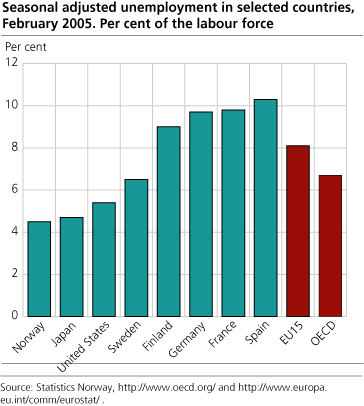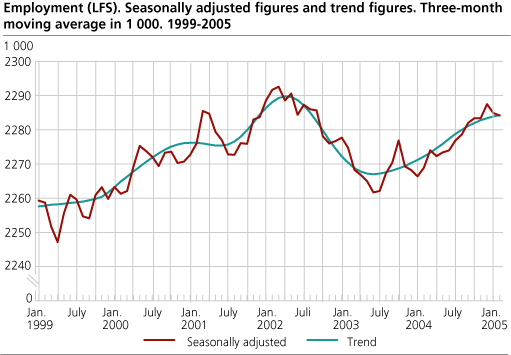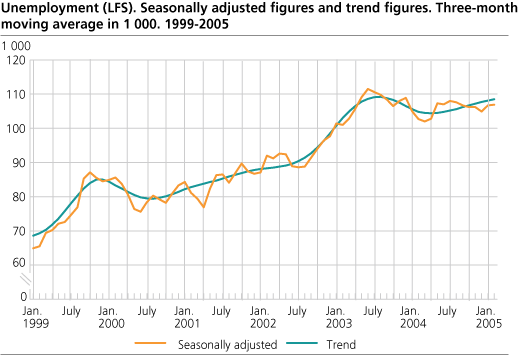Content
Published:
This is an archived release.
Stable labour market
Unemployment and employment in February stayed approximately unchanged from November last year. The figures presented in this article are adjusted for seasonal variations.
The number of unemployed for February (the January-March period) went up by 1 000 from November (October-December) last year, which is clearly inside the error margin of the Labour Force Survey (LFS). Seasonally adjusted figures of registered unemployment at job centres plus government measures to promote employment fell some in the same period (from November to February).
Following a period of negative development from the spring of 2002 to the summer of 2003, employment has ever since shown a more or less continuous rise. From November 2004 to February 2005, the number of employees rose by 1 000, which is clearly inside the LFS error margin. Employment may still be in an upward trend, but the pattern is not as evident as before.
Small changes in international figures
The seasonally adjusted unemployment rate for Norway was 4.5 per cent in February 2005, compared with 4.4 per cent in November 2004. The rate stayed approximately unchanged in the EU and OECD area, at 8.1 and 6.7 per cent respectively. In the same period, the unemployment in the USA stayed unchanged at 5.4 per cent. From November 2004 to February 2005, the unemployment rate increased from 6.4 to 6.5 per cent in Sweden, and in Finland from 8.8 to 9.0 per cent. In the same period, the figures for France and Germany went up 0.2 percentage points, and ended at 9.8 and 9.7 per cent respectively, according to figures from the OECD and Eurostat .
Man-weeks worked showed a downward trend between June 1998 and May 2003. Since then, we have seen signs of an increasing trend in these figures. From November 2004 to February 2005, man-weeks worked went up by 7 000, which is inside the LFS error margin. However, in connection with the Christmas holidays in 2004 there were not many extra days off, which lead to an extraordinary high level of man-weeks worked in November (the October-December period). Therefore, the increase is probably higher than it appears to be.
Uncertain figures
Quality tests show that the seasonally adjusted LFS unemployment figures are uncertain. The seasonal-adjustment method has problems identifying a stable seasonal pattern for this series. The random component is relatively large compared with the seasonal component. The figures should therefore be treated with caution.
The purpose of adjusting for seasonal variations is to describe the development over the last year and provide figures of change between the last two three-month periods, corrected for normal seasonal variations. In order to reduce uncertainty, the published series are three-month moving averages of the seasonally adjusted figures. For instance, the figures for February represent the average of the estimates for January, February and March.
Tables:
The statistics is published with Labour force survey.
Contact
-
Arbeidsmarked og lønn
E-mail: arbeidsmarked@ssb.no
-
Erik Herstad Horgen
E-mail: erik.horgen@ssb.no
tel.: (+47) 93 08 68 62

